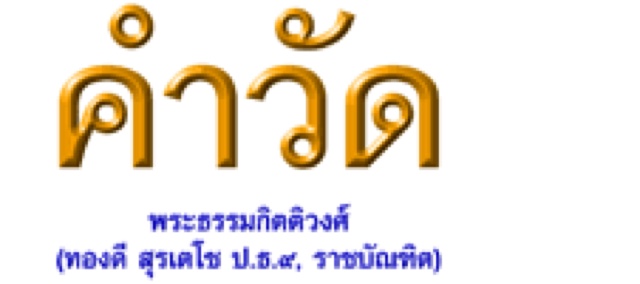Education, Agriculture and Development in Sub-Mekong Region with an intention to bring more attention to the relationship between the peripheries and the core area aka rural and urban relation.
วันเสาร์ที่ 21 พฤษภาคม พ.ศ. 2559
วันพุธที่ 18 พฤษภาคม พ.ศ. 2559
5 สิ่งที่เป็นเครื่องกางกั้นสติปัญญา (นิวรณ์ 5)
นิวรณ์ 5 คือ สิ่งที่เป็นอุปสรรคต่อการใช้สติปัญญาอย่างมีคุณภาพ เป็นสิ่งที่กางกั้นความสำเร็จ มี 5 อย่าง คือ
1.กามฉันทะ ความพอใจในกาม หมกมุ่นในกาม เราไม่ต้องอธิบายก็ได้ว่ามันกีดขวางการใช้ความสามารถและสติปัญญาได้อย่างไร
2.พยาบาท ความผูกใจเจ็บอาฆาตพยาบาทส่งผลให้การใช้สติปัญญาน้อมไปในทางตรงกันข้ามกับความเจริญงอกงาม เป็นการใช้วิชาความสามารถในทางเสื่อมเสีย หรือทำลายล้างมากกว่าในทางสร้างสรรค์
3.ถีนะมิทธะ ความง่วงเหงาหาวนอน ความเซื่องซึม ขาดความกระปรี้กระเป่า ขาดความกระตือรือร้น
4.อุทธัจจะกุกกุจจะ ความฟุ้งซ่าน เพ้อเจ้อ เป็นเครื่องปิดกั้นมิให้เข้าถึงความดี ปิดกั้นทิให้เข้าถึงสติปัญญา ไม่สามารถพุ่งตรงไปที่เป้าหมาย
5.วิจิกิจฉา ความลังเล สงสัย ทำให้ขาดศรัทธา ไม่มีการตัดสินใจ ไม่สามารถลงมือทำ ไม่มีการ take action ไม่ทำงานเชิงรุก ไม่ proactive ในกิจการงานที่รับผิดชอบ
Mangala, A Discourse on Blessings :Chanting is a way of Meditation Practice
Our morning meditation began with chanting the Mangala Sutta. It is one of the techniques to gain a state of mindfulness.The principle consists of 38 necessary habits to learn and apply in daily life to receive blessings in our business and family endeavour. Phra Arjan Sawang Kalayano from Sisaket Province, who is the project leader, smartly led the chanting.
The following website gives you the Mangala Sutta.
http://www.arrowriver.ca/dhamma/bless.html
After the chanting, we proceeded to a walking meditation on the route in front of the Centre as far the same distance as we took yesterday. But, in this morning, pieces of stone on the road are sharper than yesterday because of last night rain.
The monk spoke less as usual. Because he, most of the times, emphasised the action. He told us to begin the practice called " Jong krom" or walking meditation and led us to walk slowly on our routine path which is about a kilometre and back to the centre. Finally, he told us to stop and stand still for a while. Standing in front of the Centre building this morning
I was more relaxed and more peaceful than how I felt in yesterday practice. I felt the time today moved faster than yesterday.
While we were practising our walking meditation, I heard noise from the bird that has come to follow us every morning since our first jong krom lesson, praised us in his language.The flying animal said, "Patibat Dee Laew, Patibat Dee Laew...!!!"
At the end of the session, Phra Arjan told us the right action of making a better gesture of a "wai" (ไหว้) to give thanks to the fundamental principle of the meditation before ending the morning practice. "Raise both index fingers to touch your forehead right between your eyebrows and the gesture will be a right one".
This morning we practised how to behave yourself, how to cultivate good actions - the mindful actions.
In short,we have practised many aspects of Mangala sutta.
วันอาทิตย์ที่ 15 พฤษภาคม พ.ศ. 2559
รู้เวทนาในเวทนา
เช้านี้เราสวดมนต์ทำวัดเช้า โดยเมื่อจบบทสรรเสริญพระรัตนตรัยแล้ว เราตรงเข้าสู่บทอานาปานสติ คือการพิจารณาเห็นกายในกาย เห็นเวทนาในเวทนา เห็นจิตในจิตและเห็นธรรมในธรรมในส่วนเรื่อง เห็นเวทนาในเวทนา มีความหมายอย่างไรนั้น คำสาธยายต่อไปนี้อาจช่วยทำให้ท่านมองเห็นเวทนาในเวทนา คือมีความเข้าใจว่าเวทนาเป็นอย่างไร และเมื่อลงมือปฏิบัติอานาปานสติก็จะได้รับประสบการณ์ในส่วนเวทนาครับข้อความเป็นอย่างนี้ครับ"ดูกรภิกษุทั้งหลาย สมัยใด ภิกษุสำเหนียกอยู่ ว่าเราจักเป็นผู้กำหนดรู้
ปีติ หายใจออก ว่าเราจักเป็นผู้กำหนดรู้ปีติ หายใจเข้า สำเหนียกอยู่ ว่าเรา
จักเป็นผู้กำหนดรู้สุข หายใจออก ว่าเราจักเป็นผู้กำหนดรู้สุข หายใจเข้า สำเหนียก
อยู่ ว่าเราจักเป็นผู้กำหนดรู้จิตสังขาร หายใจออก ว่าเราจักเป็นผู้กำหนดรู้
จิตสังขาร หายใจเข้า สำเหนียกอยู่ ว่าเราจักระงับจิตสังขาร หายใจออก
ว่าเราจักระงับจิตสังขาร หายใจเข้า ดูกรภิกษุทั้งหลาย ในสมัยนั้น ภิกษุชื่อว่า
พิจารณาเห็นเวทนาในเวทนา มีความเพียร รู้สึกตัว มีสติ กำจัดอภิชฌาและ
โทมนัสในโลกเสียได้อยู่ ดูกรภิกษุทั้งหลาย เรากล่าวการใส่ใจลมหายใจออก
ลมหายใจเข้าเป็นอย่างดีนี้ ว่าเป็นเวทนาชนิดหนึ่ง ในพวกเวทนา เพราะฉะนั้นแล
ในสมัยนั้น ภิกษุจึงชื่อว่า พิจารณาเห็นเวทนาในเวทนา มีความเพียร รู้สึกตัว
มีสติ กำจัดอภิชฌาและโทมนัสในโลกเสียได้อยู่"จะเห็นได้ว่าปิติ สุข เป็นความรู้สึกอย่างหนึ่งเป็นอารมณ์ เรียกชื่อรวมๆกันว่าเวทนา เช่นสุขเวทนา ทุกขเวทนา นั่นเองสำหรับท่านที่ประสงค์รายละเอียดของอานาปานสติฉบับยาวอย่างเต็มๆ เชิญอ่านเพิ่มเติมได้ในลิงค์ต่อไปนี้ครับhttp://www.84000.org/tipitaka/pitaka2/v.php?B=14&A=3924&Z=4181
นอกจากนี้ยังหาอ่านตัวบทและคำแปลของอานาปานสติสูตรได้จากหนังสือเล่มนี้ครับ
หนังสือเล่มนี้มูลนิธิปัญญาประทึป พิมพ์แจกเป็นธรรมทานครับwww.panyaprateep.com,
www.thawsischool.com
วันเสาร์ที่ 14 พฤษภาคม พ.ศ. 2559
Maditation class from a forest monk
Sunday of May 15, 2016
After the morning prayer on the agenda at 05.00 hours, we listened to a short exciting and useful talk by the project leader on his tudong experiences. We then had a sitting meditation practice and later on took a mindful morning walk for a kilometre towards the canal in front of the centre and back. While we were making our mindful walking the monk told us how to behave ourselves - how to manage our physical positions and our minds and breaths, here and there once in a while. He spoke less but chose to emphasise critical procedures. When he came near me, he showed us how to manage our hands. He told us to take it easy by just hanging our hands down beside our body relaxingly. "Do not hold them up like that will make you feel stressed," he said."Then bring one hand to put above the other in front of your stomach". He showed us how to do it. When he placed one hand on the other, he said, "ngab (แงบ) like this". It was an impressive expression. When I followed his explanation, I was surprised to find out I was more comfortable!
I think we should do each prayer separately so that we can understand the concept and the details of practices more quickly, especially for senior followers.
The links below show you more details of The Noble Paths and the process of Anapanasati.
วันศุกร์ที่ 13 พฤษภาคม พ.ศ. 2559
การทำที่สุดแห่งกองทุกข์หมายถึงทำอะไร?
ในหน้า 12 ของหนังสือเล่มนี้ เป็นบทสวดมนต์แปล หัวข้อ สังเวคปริกิตตนปาฐะ ซึ่งเป็นหัวข้อลำดับที่ 5 ของบทสวดการทำวัตรเช้า ความเริ่มต้น ว่า พระตถาคตเจ้าเกิดขึ้นแล้วในโลกนี้ ท่านเป็นผู้ไกลจากกิเลส ตรัสรู้ชอบได้โดยพระองค์เอง และพระธรรมที่ทรงแสดง
* เป็นธรรมเครื่องออกจากทุกข์
* เป็นเครื่องสงบกิเลส
* เป็นไปเพื่อปรินิพพาน
* เป็นไปเพื่อความรู้พร้อม
โดยระบุว่า นี่เป็นธรรมที่พระสุคตประกาศ...
ทั้งยังกล่าวต่อไปว่า...เมื่อพวกเราได้ฟังที่พระองค์ทรงประกาศแล้วจึงได้รู้อย่างนี้ว่า
* แม้ความเกิดก็เป็นทุกข์
* แม้ความตายก็เป็นทุกข์
* แม้ความโศก ความร่ำไรรำพัน ความไม่สบายกาย ความไม่สบายใจ ความคับแค้นใจก็เป็นทุกข์
* ความประสบกับสิ่งที่ไม่เป็นที่รักที่พอใจก็เป็นทุกข์
* ความพลัดพรากจากสิ่งเป็นที่รักที่พอใจก็เป็นทุกข์
* มีความปรารถนาสิ่งใดไม่ได้สิ่งนั้น นั่นก็เป็นทุกข์
ว่าโดยย่ออุปาทานขันธ์ทั้งห้าเป็นตัวทุกข์...
จากนั้น บทสวดมนต์กล่าวถึง ขันธ์ห้า อันได้แก่ รูป เวทนา สัญญา สังขาร วิญญาณ โดยกล่าวเพิ่มเติมว่า ทั้งห้าขันธ์นี้เป็นที่ตั้งแห่งความยึดมั่น (อุปาทาน)
นอกจากนี้ ยังกล่าวอีกด้วยว่า ขันธ์ทั้งห้านี้ไม่เที่ยง คือเป็นอนิจจัง และไม่ใช่ตัวตน (อะนัตตา)
สุดท้ายบอกอีกว่า
...พวกเราทั้งหลายป็นผู้ถูกครอบงำแล้วด้วยความเกิด ความแก่และความตาย ความโศก ความร่ำไรรำพัน ความไม่สบายกาย ความไม่สบายใจ ความคับแค้นใจทั้งหลาย
พวกเราเป็นผู้ถูกความทุกข์หยั่งเอาแล้ว!
เป็นผู้มีความทุกข์เป็นเบื้องหน้าแล้ว!!!
ทำไฉนการทำที่สุดแห่งกองทุกข์ทั้งสิ้นนี้จะพึงปรากฏชัดแก่เราได้?
ท่านผู้อ่านครับ สงสัยหรือไม่ครับว่าการทำที่สุดแห่งกองทุกข์นี้ท่านเข้าใจว่าหมายถึงอะไร?
สมัครสมาชิก:
ความคิดเห็น (Atom)





